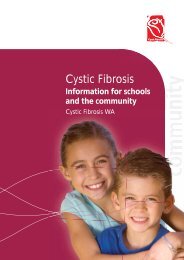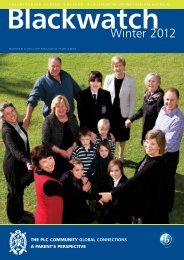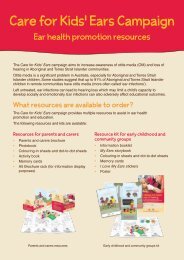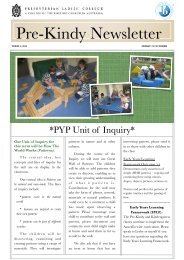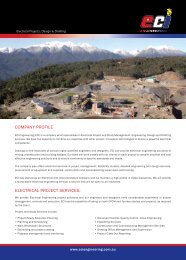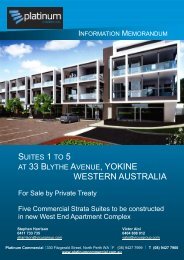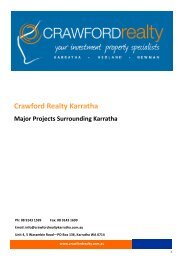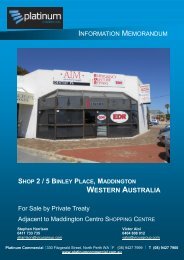Port Hedland Australia's iron ore boom town - Aussiehome
Port Hedland Australia's iron ore boom town - Aussiehome
Port Hedland Australia's iron ore boom town - Aussiehome
You also want an ePaper? Increase the reach of your titles
YUMPU automatically turns print PDFs into web optimized ePapers that Google loves.
Hot spot | port hedland<br />
Case study<br />
Katie Joy<br />
Former St John Ambulance paramedic<br />
Katie Joy is one of the great success<br />
stories to come out of <strong>Port</strong> <strong>Hedland</strong> –<br />
within three years, Katie went from a<br />
96-hours-a-week job to early retirement<br />
in her early 30s through riding the <strong>Port</strong><br />
<strong>Hedland</strong> <strong>boom</strong>.<br />
After extensive research convinced<br />
her that the billions of dollars of<br />
projects from one of the largest<br />
companies in the world spelt great<br />
things ahead for <strong>Port</strong> <strong>Hedland</strong>, she<br />
used equity from an existing property<br />
in Perth to purchase two investment<br />
properties for $358,000 and $360,000<br />
within a fortnight of each other in<br />
February 2006. She chose these<br />
properties based on their ‘executive<br />
style’ presentation, which appealed to<br />
company tenants, and the fact they<br />
were low maintenance in nature.<br />
Just over a year later, she plucked up<br />
the courage to purchase a $760,000<br />
double-st<strong>ore</strong>y house in <strong>Port</strong> <strong>Hedland</strong><br />
(June 2007) and then a $560,000 South<br />
<strong>Hedland</strong> three-bedroom home in<br />
October 2007. As her equity continued<br />
to rise on the back of the commodities<br />
<strong>boom</strong>, she purchased once again<br />
in January 2008, buying a $730,000<br />
South <strong>Hedland</strong> home.<br />
While living in <strong>Port</strong> <strong>Hedland</strong>, Katie<br />
self-managed her properties but<br />
once she moved back to Perth they<br />
were managed by local real estate<br />
agents, including Crawford Realty.<br />
Now retired since 2008, with a $4.3m<br />
portfolio, $1.5m of equity and $8,500<br />
per week rent, Katie continues to hold<br />
her investments.<br />
28<br />
$635bn stimulus package.<br />
With a double dip recession being<br />
speculated by some economists for the<br />
US, there are concerns that this would<br />
translate into lower demand for Chinese<br />
manufactured goods that in turn would<br />
slow China’s relentless growth (and<br />
<strong>iron</strong> imports from <strong>Port</strong> <strong>Hedland</strong>). This<br />
said, the world’s leading economists<br />
continue to see very strong GDP growth<br />
for China in 2011, which will only be<br />
slightly lower than its 10-year average<br />
of 10.1%:<br />
• 9.9% according to the IMF<br />
• 9.7% according to the OECD<br />
• 9.1% according to the Asian<br />
Development Bank<br />
• 8.5% according to the World Bank<br />
Note, their f<strong>ore</strong>casts are nearly<br />
three times the 3.5% IMF f<strong>ore</strong>cast for<br />
Australia’s 2011 GDP.<br />
Consequently, a serious slow-down<br />
in China (and theref<strong>ore</strong> <strong>iron</strong> <strong>ore</strong> exports<br />
from Australia) does not appear likely.<br />
2. Mining tax threat<br />
The Mineral Resource Rent Tax<br />
(MRRT) negotiated by BHP Billiton<br />
and Rio Tinto with the Gillard Labor<br />
Government immediately bef<strong>ore</strong> the<br />
August 2010 election was a ‘watered<br />
down’ version of the aggressive<br />
Resource Super Profits Tax, which was<br />
attacked by mining companies, the<br />
Western Australian government and the<br />
federal opposition as devastating for the<br />
mining industry.<br />
The future of the MRRT is<br />
uncertain. Labor lost numerous seats<br />
in Western Australia and Queensland<br />
due to the proposed tax but The<br />
Australian Greens party (who now<br />
hold significant power in parliament)<br />
are in favour of increased taxation on<br />
mining companies.<br />
However, the potential for such<br />
a tax did not stop Rio Tinto from<br />
announcing immediately bef<strong>ore</strong> the<br />
election an $862m expansion of one of<br />
its Pilbara ports. Indeed, Rio Tinto said<br />
this expansion would be the start of a<br />
multi-billion dollar enlargement of its<br />
Pilbara operations (estimated by Merrill<br />
Lynch to cost up to $11bn).<br />
As they say, actions speak louder than<br />
words and BHP Billiton was also party<br />
to the same agreement as Rio Tinto.<br />
While FMG continues to protest any<br />
future tax, the fact that the MRRT<br />
headline rate has been reduced from<br />
40% to 30% and it allows BHP Billiton<br />
to depreciate its current operations at<br />
market value (rather than historic book<br />
value) bef<strong>ore</strong> payment of any tax means<br />
that the real sting from any tax has<br />
already been taken out.<br />
3. High price point<br />
A median house value of $955,000<br />
will make any investor draw their<br />
breath. However, so is a 10% yielding,<br />
cash flow positive property with<br />
strong capital growth potential.<br />
Further, investors have the option<br />
of buying in South <strong>Hedland</strong> (median<br />
house value of approximately<br />
$630,000) on the same yield and<br />
growth prospects.<br />
Ultimately investors need to<br />
weigh up the higher price point, with<br />
immediate cash in their pocket and the<br />
future capital growth prospects.<br />
Opportunity to ride the <strong>boom</strong><br />
As the second leg of the commodities<br />
<strong>boom</strong> begins in earnest, property<br />
investors have a unique opportunity<br />
to capture substantial capital gains<br />
and 10%-plus yields in <strong>Port</strong> <strong>Hedland</strong>’s<br />
property market.<br />
Should house values continue to<br />
rise by even half the 10-year average<br />
of 18%, this will mean capital gains<br />
of some $90,000 per annum. Rich<br />
rewards indeed.<br />
Investors should also consider<br />
where else in Australia has over<br />
$500m in civic and local infrastructure<br />
projects planned and underway to<br />
specifically improve the ‘liveability’ of<br />
the <strong>town</strong>’s population. Or which other<br />
<strong>town</strong> actually has credible population<br />
growth plans to double in size within<br />
the next 15 years but also immense land<br />
supply constraints.<br />
Many investors missed yesterday’s<br />
commodities <strong>boom</strong>; others, however,<br />
will not miss today’s.<br />
Flynn De Freitas is principal of Omega<br />
Investments, a boutique firm specialising<br />
in residential property investment in<br />
regional mining <strong>town</strong>s. Utilising his<br />
training and experience as a former<br />
management consultant and investment<br />
banker, he has developed an extensive<br />
knowledge and understanding of <strong>town</strong>s<br />
exposed to the commodities <strong>boom</strong>. For<br />
investment opportunities please visit<br />
www.omegainvestments.com.au<br />
www.yipmag.com.au




